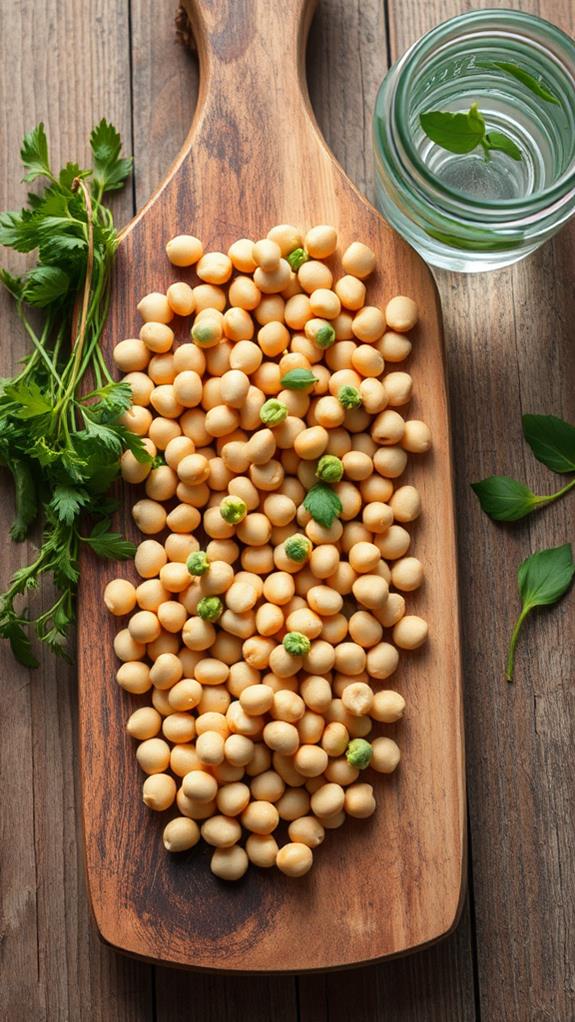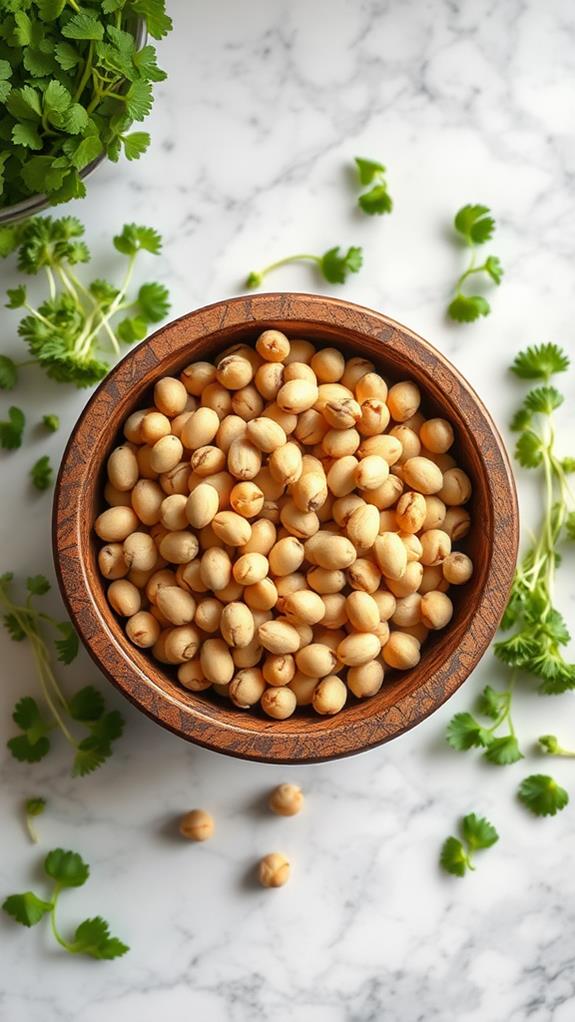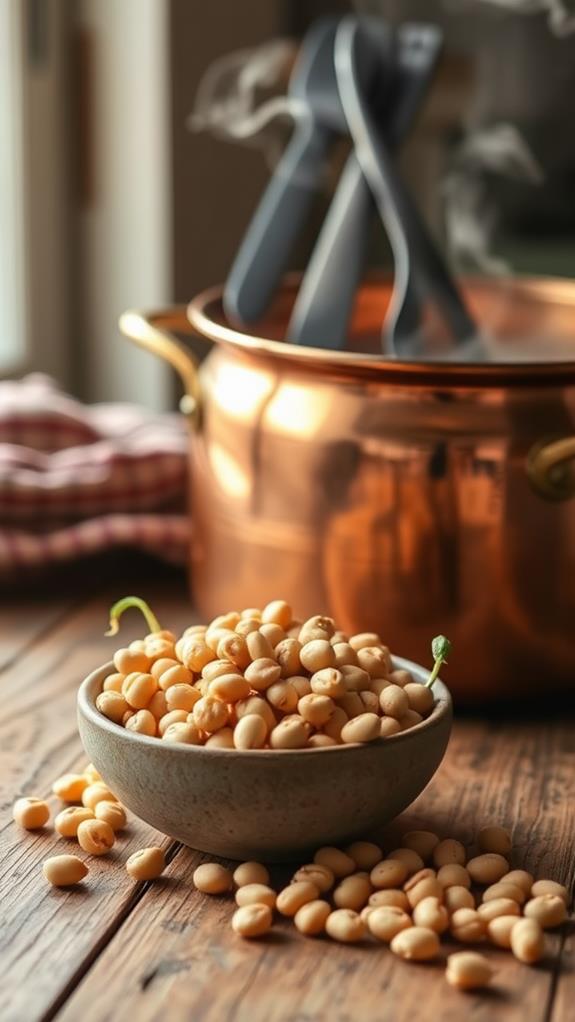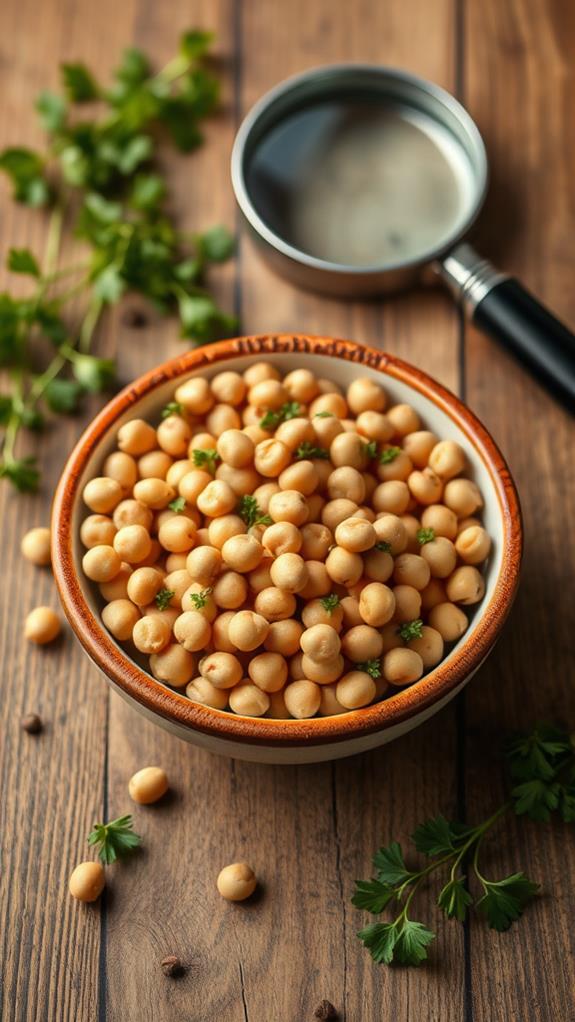Is It Safe to Eat Sprouted Pinto Beans
Sprouted pinto beans can be safe to eat, but you'll need to take precautions. While sprouting enhances nutritional value and digestibility, it also increases the risk of bacterial contamination. To guarantee safety, thoroughly rinse the sprouts and cook them properly. Boiling, steaming, or sautéing for the recommended time kills harmful bacteria. Always inspect your sprouts for signs of spoilage, such as sliminess or off-odors, and discard any that look suspicious. Pregnant women, children, and those with weakened immune systems should avoid raw sprouts altogether. When handled and prepared correctly, sprouted pinto beans can be a nutritious addition to your diet. Exploring proper storage and cooking techniques can further enhance your sprouted bean experience.
This post may contain affiliate links. If you make a purchase through these links, I may earn a commission at no additional cost to you. Additionally, portions of this post may be generated using artificial intelligence (AI) technology. While we strive for accuracy, please be aware that AI-generated content may not always be perfect and should be fact-checked when necessary.
The Spatula Scoops
- Sprouted pinto beans can be safe to eat when proper food safety protocols are followed during the sprouting process.
- Bacterial contamination risks, particularly from Salmonella and E. coli, are the primary safety concern with sprouted beans.
- Cooking sprouted pinto beans reduces bacterial risks and antinutrient levels, making them safer to consume.
- Immunocompromised individuals, pregnant women, and other high-risk groups should avoid consuming raw sprouted beans.
- Properly stored and prepared sprouted pinto beans offer increased nutrient availability and potential health benefits.
Understanding Bean Sprouting

Bean sprouting is a natural process that occurs when beans are exposed to moisture and warmth. When you soak beans, they absorb water and begin to germinate, breaking through their outer shell. This process activates enzymes within the bean, initiating various biochemical changes. Similar to green coffee beans, sprouted beans retain their natural color and offer unique health benefits due to their unprocessed state.
As the bean sprouts, it develops a small root and shoot. You'll notice these changes visually as the bean's appearance transforms. The sprouting process can take anywhere from a few days to a week, depending on the bean variety and environmental conditions.
During sprouting, the bean's nutritional profile changes. It often becomes easier to digest and may increase in certain nutrients, such as vitamin C and some B vitamins. However, it's vital to comprehend that sprouting can also affect the bean's texture and flavor.
When it comes to pinto beans specifically, they're a popular choice for sprouting due to their mild flavor and versatility. As with any bean, proper hygiene and careful monitoring are essential during the sprouting process to prevent bacterial growth. Understanding these fundamentals of bean sprouting is necessary for anyone considering incorporating sprouted pinto beans into their diet.
Nutritional Changes in Sprouted Beans
During the sprouting process, pinto beans undergo significant nutritional changes. You'll find that the protein content increases while some carbohydrates break down. This transformation enhances the bioavailability of nutrients, making them easier for your body to absorb. The sprouting process also reduces phytic acid levels, which can interfere with mineral absorption.
Here's a breakdown of key nutritional changes:
| Nutrient | Change | Benefit |
|---|---|---|
| Protein | Increases | Improved amino acid profile |
| Vitamins | Increases | Higher vitamin C and B vitamins |
| Enzymes | Activates | Better digestibility |
You'll notice that sprouted pinto beans have a slightly different taste and texture compared to their unsprouted counterparts. They're often crunchier and have a milder, less "beany" flavor. This change in taste profile can make them more appealing in salads or as a raw snack.
It's important to note that while sprouting enhances certain nutrients, it may decrease others. For example, some minerals might become slightly less concentrated due to the increased water content in sprouts. However, the overall nutritional profile of sprouted pinto beans is generally considered more beneficial than unsprouted beans.
Potential Health Benefits

When you eat sprouted pinto beans, you're tapping into a range of potential health benefits. These sprouted legumes offer increased nutrient availability, as the sprouting process breaks down some compounds that can inhibit mineral absorption. The process of sprouting also reduces anti-nutritional factors like lectins, which can improve overall nutrient absorption and digestive health. You'll also find that sprouted beans are often easier to digest, thanks to the reduction of certain hard-to-process components during germination.
Increased Nutrient Availability
One of the most compelling reasons to consume sprouted pinto beans is their enhanced nutritional profile. When you sprout pinto beans, you're fundamentally kick-starting the germination process, which leads to significant changes in the beans' nutrient composition. This process breaks down complex compounds, making nutrients more bioavailable for your body to absorb.
During sprouting, several key changes occur:
- Increased vitamin content, particularly B vitamins and vitamin C
- Reduced phytic acid levels, improving mineral absorption
- Enhanced enzyme activity, aiding digestion
You'll find that sprouted pinto beans are easier to digest than their unsprouted counterparts. The sprouting process begins to break down complex carbohydrates and proteins, resulting in a more easily digestible food. This can be particularly beneficial if you have sensitive digestion or are looking to maximize nutrient uptake from your meals.
Moreover, sprouting can increase the antioxidant content of pinto beans. These antioxidants help protect your cells from damage caused by free radicals, potentially reducing the risk of chronic diseases. By incorporating sprouted pinto beans into your diet, you're not just consuming a protein-rich food, but also a nutrient-dense one.
Enhanced Digestibility
The enhanced digestibility of sprouted pinto beans offers a range of potential health benefits. When you consume sprouted pinto beans, you're taking advantage of their improved nutrient absorption. The sprouting process breaks down complex carbohydrates and proteins into simpler forms, making them easier for your body to digest and utilize.
This enhanced digestibility can lead to reduced bloating and gas, common issues associated with eating legumes. You'll likely experience less discomfort after meals, as your digestive system won't have to work as hard to break down the beans. Additionally, the increased bioavailability of nutrients means you'll get more nutritional value from each serving.
The sprouting process also reduces antinutrients like phytic acid and enzyme inhibitors. These compounds can interfere with nutrient absorption, so their reduction further enhances the beans' digestibility. You'll benefit from improved mineral absorption, particularly for iron, zinc, and calcium. This can be especially valuable if you're following a plant-based diet or have specific nutritional needs. Remember, while sprouted pinto beans offer these digestive benefits, it's still important to introduce them gradually into your diet to allow your system to adjust.
Antioxidant Content Boost
Sprouted pinto beans pack a powerful antioxidant punch, offering significant health benefits beyond their enhanced digestibility. When you sprout pinto beans, you're fundamentally kickstarting their growth process, which leads to an increase in antioxidant compounds. These antioxidants help protect your cells from damage caused by free radicals, potentially reducing your risk of chronic diseases.
The antioxidant boost in sprouted pinto beans includes:
- Increased vitamin C content
- Higher levels of polyphenols
- Enhanced flavonoid production
You'll find that sprouted pinto beans contain more bioavailable antioxidants compared to their unsprouted counterparts. This means your body can absorb and utilize these beneficial compounds more efficiently. The sprouting process breaks down certain antinutrients, allowing for better nutrient absorption overall.
Safety Concerns and Risks
Safety concerns surrounding sprouted pinto beans primarily revolve around bacterial contamination. When you sprout beans, you're creating an environment that's ideal for bacterial growth. Warm, moist conditions can lead to the proliferation of harmful bacteria like Salmonella or E. coli. This risk is particularly high if you're not careful with your sprouting process. Similar to chicken left out overnight, sprouted beans can quickly enter the "Danger Zone" where bacteria thrive, potentially doubling in number every 20 minutes under ideal conditions.
To mitigate these risks, you'll need to follow proper food safety protocols. Always use clean water and sterilized equipment when sprouting. It's essential to rinse your sprouts thoroughly and frequently during the sprouting process. You should also be aware that consuming raw sprouts carries a higher risk than cooked ones. If you're immunocompromised, pregnant, or in a high-risk group, you might want to avoid raw sprouts altogether.
Another concern is the potential for increased levels of antinutrients in sprouted beans. While sprouting can reduce some antinutrients, it may not eliminate them entirely. These compounds can interfere with nutrient absorption, so it's important to be aware of this potential drawback. Cooking sprouted beans can help further reduce antinutrient levels and eliminate bacterial risks.
Proper Storage Techniques

Proper storage is essential for maintaining the safety and quality of your sprouted pinto beans. Once you've sprouted your beans, it's indispensable to store them correctly to prevent bacterial growth and preserve their nutritional value. Always refrigerate your sprouted beans in an airtight container, as this will slow down the sprouting process and keep them fresh for up to a week.
To guarantee optimum storage of your sprouted pinto beans, follow these key steps:
- Rinse the sprouts thoroughly with cool water to remove any debris or loose hulls.
- Pat the sprouts dry using a clean cloth or paper towel to remove excess moisture.
- Place the dried sprouts in a perforated plastic bag or container with small air holes to allow for proper ventilation.
When storing your sprouted pinto beans, it's important to monitor them regularly for any signs of spoilage, such as a slimy texture, unpleasant odor, or discoloration. If you notice any of these indicators, discard the sprouts immediately. By following these proper storage techniques, you'll extend the shelf life of your sprouted pinto beans and guarantee they remain safe for consumption.
Identifying Safe Sprouted Beans
A keen eye is essential when identifying safe sprouted pinto beans. You'll want to look for sprouts that are crisp, fresh-looking, and have a light color. Avoid any sprouts that appear slimy, discolored, or have an off-putting odor. These are signs of potential bacterial growth, which can lead to foodborne illness.
When examining your sprouted pinto beans, check for any signs of mold. This might appear as fuzzy patches or dark spots on the sprouts or beans. If you see mold, it's best to discard the entire batch. Additionally, pay attention to the length of the sprouts. Ideally, they should be about 1/4 to 1/2 inch long. Longer sprouts may indicate that the beans have been sprouting for too long, potentially increasing the risk of bacterial contamination.
It's imperative to thoroughly rinse your sprouted pinto beans before consuming them. This helps remove any surface bacteria that may have developed during the sprouting process. If you're unsure about the safety of your sprouted beans, it's always better to err on the side of caution and avoid eating them.
Cooking Methods for Sprouted Beans

Culinary enthusiasts often debate the best methods for cooking sprouted pinto beans. When you're ready to prepare your sprouted beans, you'll want to consider a few key cooking techniques to guarantee both safety and flavor. First, always rinse your sprouted beans thoroughly before cooking to remove any potential contaminants.
- Boiling: Add beans to a pot of water, bring to a boil, then simmer for 30-45 minutes.
- Steaming: Place beans in a steamer basket over boiling water for 20-30 minutes.
- Sautéing: Heat oil in a pan, add beans, and cook for 10-15 minutes, stirring frequently.
Regardless of the method you choose, it's imperative to cook sprouted beans until they're tender. This not only improves digestibility but also eliminates any potential harmful bacteria. You'll know they're done when you can easily mash a bean with a fork. Remember, cooking times may vary depending on the size and age of your beans. Always taste-test for doneness and adjust cooking time as needed. By following these guidelines, you'll guarantee your sprouted pinto beans are both safe and delicious.
Alternatives to Sprouted Beans
While sprouted pinto beans offer unique nutritional benefits, you might be looking for alternatives. If you're not keen on sprouting or want to avoid potential risks, there are several options you can consider.
Unsprouted pinto beans are a classic choice, offering similar nutritional value without the sprouting process. You'll need to soak and cook them thoroughly, but they're versatile and widely available. Lentils are another excellent alternative, cooking faster than pinto beans and providing comparable protein content. They're also rich in fiber and various micronutrients.
For a different flavor profile, try chickpeas. They're nutrient-dense and work well in salads, soups, and as a base for hummus. If you're looking for a non-legume option, quinoa is a protein-rich pseudocereal that cooks quickly and offers a complete amino acid profile.
Canned beans are a convenient alternative to sprouted beans. They're pre-cooked and ready to use, saving you time in the kitchen. Just be mindful of added sodium in some canned varieties. Opt for low-sodium options or rinse regular canned beans before use to reduce salt content.
Expert Opinions on Consumption

What do the experts say about eating sprouted pinto beans? The consensus among nutritionists and food safety experts is that sprouted pinto beans can be safe and nutritious when prepared correctly. However, they also warn of potential risks associated with improper sprouting and handling.
Experts highlight three main points regarding sprouted pinto bean consumption:
- Improved nutrient bioavailability: Sprouting increases the availability of vitamins, minerals, and antioxidants.
- Reduced antinutrients: The sprouting process breaks down phytic acid and enzyme inhibitors, making the beans easier to digest.
- Potential foodborne illness risk: Improper sprouting conditions can lead to bacterial growth, particularly Salmonella and E. coli.
You'll find that most experts recommend cooking sprouted pinto beans thoroughly before eating. This step eliminates potential pathogens and guarantees food safety. They advise against consuming raw sprouted beans due to the risk of bacterial contamination.
When sprouting at home, you should follow strict hygiene practices and use clean, chlorine-free water. Store-bought sprouts should be refrigerated and consumed quickly. If you're immunocompromised or pregnant, experts suggest avoiding sprouted beans altogether due to the higher risk of foodborne illness.
Frequently Asked Questions
Can Sprouted Pinto Beans Be Eaten Raw?
While you can eat sprouted pinto beans raw, it's not recommended. Raw sprouted beans contain compounds that can be difficult to digest and may cause gastrointestinal discomfort. They also carry a risk of foodborne illness due to potential bacterial growth during the sprouting process. For ideal safety and digestibility, it's best to cook sprouted pinto beans thoroughly before consumption. Cooking not only enhances flavor but also eliminates potential pathogens and breaks down complex carbohydrates, making the beans easier for your body to process.
How Long Do Sprouted Pinto Beans Last in the Refrigerator?
You'd think sprouted pinto beans would last forever, right? Well, not quite. In your refrigerator, they'll typically stay fresh for 3-5 days. It's essential to store them in an airtight container to maintain their quality. Remember, the longer you keep them, the more their nutritional value and texture may deteriorate. If you notice any off-odors or signs of mold, it's best to discard them. Always prioritize food safety over trying to stretch their shelf life.
Are Canned Sprouted Pinto Beans Available in Stores?
You'll find that canned sprouted pinto beans aren't widely available in stores. Most retailers stock traditional canned pinto beans, but sprouted varieties are less common. Your best bet is to check health food stores or specialty markets, as they're more likely to carry these products. Alternatively, you can find them online through e-commerce platforms or directly from manufacturers. If you're keen on sprouted beans, you might consider sprouting them yourself at home for fresher results.
Can You Sprout Dried Pinto Beans at Home?
Yes, you can sprout dried pinto beans at home. It's a simple process that requires minimal effort. First, rinse your beans and soak them overnight. Then, drain and rinse them again. Place the beans in a jar covered with a mesh lid or cheesecloth. Rinse and drain twice daily, keeping them in a dark, room-temperature spot. In 3-4 days, you'll see small sprouts emerge. Once they reach your desired length, rinse thoroughly and enjoy your homemade sprouted pinto beans.
Do Sprouted Pinto Beans Have a Different Flavor Than Unsprouted Ones?
You'll notice a distinct difference in flavor when you eat sprouted pinto beans compared to unsprouted ones. The sprouting process alters the bean's chemical composition, resulting in a sweeter, nuttier taste. You'll also find that sprouted beans have a milder, less "beany" flavor. Their texture changes too, becoming slightly crunchier and less starchy. This transformation occurs because sprouting breaks down complex carbohydrates and proteins, making the beans easier to digest and enhancing their nutritional value.
Conclusion
In summary, you've learned that sprouted pinto beans can be safe to consume when handled appropriately. But have you considered the potential risks? While they offer nutritional advantages, it's vital to follow proper storage and cooking techniques. Remember to identify safe sprouts and be aware of the safety concerns. If you're unsure, there are always alternatives to try. Ultimately, it's up to you to weigh the pros and cons before incorporating sprouted pinto beans into your diet.





